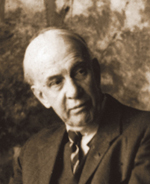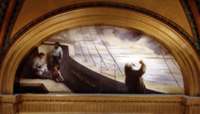William Brantley Van IngenWilliam B. Van Ingen was born in Philadelphia and studied at the Pennsylvania Academy of the Fine Arts as a pupil of Thomas Eakins and Christian Schuessele. After completing his studies at the Academy, he moved to New York where he apprenticed under three noted stained glass artists: John La Farge, Francis Lathrop, and Lewis C. Tiffany. In addition to his talent in stained glass, Van Ingen was also a noted and prolific muralist. He was best known in artistic circles for his commission by the U.S. Government to paint murals in the Panama Canal Administration Building. The five murals, which were installed in 1915, comprise an area of 1,000 square feet and illustrate different phases in the canal's construction. Van Ingen was selected to paint the murals at the request of canal builder Major Gen. George R. Goethals. He also received commissions to paint murals in the Library of Congress in Washington, D.C., Pennsylvania State Capitol in Harrisburg, New Jersey State Capitol in Trenton, U.S. Mint in Philadelphia, and Federal buildings in Chicago and Indianapolis. Van Ingen was awarded the Pennsylvania State Capitol commission in 1902, and chose to represent Pennsylvania's religious development through fourteen painted murals that reside in the lunette spaces of the Capitol's first floor along the south corridor. He also designed the twenty-four circular opalescent stained glass windows located in the House and Senate Chambers. These incredible works of art symbolize the history, art, science, and industry of Pennsylvania. After receiving a commission from financier, Charles T. Yerkes to make a Japanese room for his New York residence, Van Ingen visited Japan and made extensive studies in Japanese art. He also painted murals for private residences in Philadelphia. During 1937-1938, under a Depression-era grant from the federal government's Works Projects Administration, Van Ingen created over 4,500 square feet of murals for the University at Albany in Hawley Hall. Although best known for his artistic accomplishments, Van Ingen was also a strong advocate of preserving New York's public parklands. He lectured and wrote on the topic and served as chairman of the parks committee of the New York Grand Jurors Association. Van Ingen spent the latter part of his life at the Masonic Home in Utica, New York, where he died after a long illness on February 6, 1955, at age ninety-six. |


